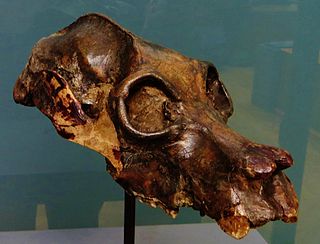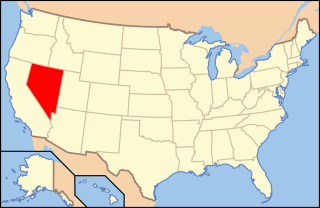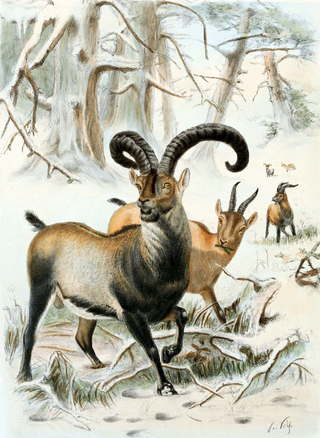
Mpinguari, or Mpinguary, (also called the Juma) are mythical monstrous jungle-dwelling spirits from Brazilian folklore said to protect the forest and its animals.

Mpinguari, or Mpinguary, (also called the Juma) are mythical monstrous jungle-dwelling spirits from Brazilian folklore said to protect the forest and its animals.
There are various depictions of the mapinguari. Prior to 1933, traditional folklore describe it as a former human shaman turned into a hairy humanoid cyclops. [1] This version is often said to have a gaping mouth on its abdomen, [2] with its feet turned backwards. Creatures with such feet, which confuse those trying to track it, are found in folklore around the world. [1]
In the latter half of the 20th century, some cryptozoologists speculated that the mapinguari might be an unknown primate, akin to Bigfoot. [1]
Others claim that it is a modern-day sighting of a giant ground sloth, an animal estimated to have gone extinct at the end of the Late Pleistocene. [2] [3] These later descriptions may be attributed to David C. Oren, an ornithologist, who heard stories of the creature and hypothesized they might be the extinct sloths. This was met by criticism by scientists at the time, but an article Oren published in 1993 was picked up by major news papers despite no evidence. [1] Skeptics point out that there have not been any fossil records of ground sloths for thousands of years [4]
A 2023 academic study of the 1995 discovery of giant sloth bones “modified into primordial pendants” suggested that humans lived in the Americas contemporaneous with the giant sloth, specifically that “it may have served as inspiration for the Mapinguari, a mythical beast that, in Amazonian legend, had the nasty habit of twisting off the heads of humans and devouring them.” [5]
According to Felipe Ferreira Vander Velden, its name is a combination of the Tupi-Guarani words "mbappé", "pi", and "guari", meaning "a thing that has a bent [or] crooked foot [or] paw". [6] Other names by which they are referred to include the Karitiana kida harara, [6] and the Machiguenga segamai. [2] [3]
A reference to Mapinguari occurs in the 2020 animated film The Red Scroll , during the final scene when the character Wupa transforms into a giant sloth monster. [7]

A mammoth is any species of the extinct elephantid genus Mammuthus. The various species of mammoth were commonly equipped with long, curved tusks. They lived from the late Miocene epoch into the Holocene about 4,000 years ago, and various species existed in Africa, Europe, Asia, and North America. Mammoths are more closely related to living Asian elephants than African elephants.

Megatherium is an extinct genus of ground sloths endemic to South America that lived from the Early Pliocene through the end of the Pleistocene. It is best known for the elephant-sized type species M. americanum, sometimes known as the giant ground sloth, or the megathere, native to the Pampas through southern Bolivia during the Pleistocene. Various other smaller species belonging to the subgenus Pseudomegatherium are known from the Andes.

In zoology, megafauna are large animals. The most common thresholds to be a megafauna are weighing over 46 kilograms (100 lb) or weighing over a tonne, 1,000 kilograms (2,205 lb). The first of these include many species not popularly thought of as overly large, and being the only few large animals left in a given range/area, such as white-tailed deer, Thomson's gazelle, and red kangaroo.

Vertebrate paleontology is the subfield of paleontology that seeks to discover, through the study of fossilized remains, the behavior, reproduction and appearance of extinct vertebrates. It also tries to connect, by using the evolutionary timeline, the animals of the past and their modern-day relatives.

Ground sloths are a diverse group of extinct sloths in the mammalian superorder Xenarthra. Ground sloths varied widely in size, with the largest genera Megatherium and Eremotherium being around the size of elephants. Ground sloths are a paraphyletic group, as living tree sloths are thought to have evolved from ground sloth ancestors.
Folk memory, also known as folklore or myths, refers to past events that have been passed orally from generation to generation. The events described by the memories may date back hundreds, thousands, or even tens of thousands of years and often have a local significance. They may explain physical features in the local environment, provide reasons for cultural traditions or give etymologies for the names of local places.

Archaeoindris fontoynontii is an extinct giant lemur and the largest primate known to have evolved on Madagascar, comparable in size to a male gorilla. It belonged to a family of extinct lemurs known as "sloth lemurs" (Palaeopropithecidae) and, because of its extremely large size, it has been compared to the ground sloths that once roamed North and South America. It was most closely related to Palaeopropithecus, the second largest type of sloth lemur. Along with the other sloth lemurs, Archaeoindris was related to the living indri, sifakas, and woolly lemurs, as well as the recently extinct monkey lemurs (Archaeolemuridae). The genus, Archaeoindris, translates to "ancient indri-like lemur", even though it probably became extinct recently, around 350 BCE.

Palaeopropithecus is a recently extinct genus of large sloth lemurs from Madagascar related to living lemur species found there today. Three species are known, Palaeopropithecus ingens, P. maximus, and P. kelyus. Radiocarbon dates indicate that they may have survived until around 1300–1620 CE. Malagasy legends of the tretretretre or tratratratra are thought to refer to P. ingens.

Megalonyx is an extinct genus of ground sloths of the family Megalonychidae, native to North America. It evolved during the Pliocene Epoch and became extinct during at the end of the Late Pleistocene, living from ~5 million to ~13,000 years ago. The type species, M. jeffersonii, the youngest and largest known species, measured about 3 meters (9.8 ft) in length and weighed up to 1,000 kilograms (2,200 lb).

Pleistocene rewilding is the advocacy of the reintroduction of extant Pleistocene megafauna, or the close ecological equivalents of extinct megafauna. It is an extension of the conservation practice of rewilding, which aims to restore functioning, self-sustaining ecosystems through practices that may include species reintroductions.

Melbourne Bone Bed is a paleontological site located at Crane Creek in Melbourne, in the U.S. state of Florida. This site contains fossils from the Late Pleistocene period 20,000 to 10,000 years before the present. The fossils include extinct animals such as varieties of camels, dire wolves, Florida cave bears, giant armadillos, giant beavers, giant bison, giant ground sloths, mammoths, mastodons, saber-toothed cats, and tapirs.

The woolly mammoth is an extinct species of mammoth that lived from the Middle Pleistocene until its extinction in the Holocene epoch. It was one of the last in a line of mammoth species, beginning with the African Mammuthus subplanifrons in the early Pliocene. The woolly mammoth began to diverge from the steppe mammoth about 800,000 years ago in Siberia. Its closest extant relative is the Asian elephant. The Columbian mammoth lived alongside the woolly mammoth in North America, and DNA studies show that the two hybridised with each other.

The Late Pleistocene to the beginning of the Holocene saw numerous extinctions of predominantly megafaunal animal species, which resulted in a collapse in faunal density and diversity across the globe. The extinctions during the Late Pleistocene are differentiated from previous extinctions by the widespread absence of ecological succession to replace these extinct megafaunal species, and the regime shift of previously established faunal relationships and habitats as a consequence. The timing and severity of the extinctions varied by region and are thought to have been driven by varying combinations of human and climatic factors. Human impact on megafauna populations is thought to have been driven by hunting ("overkill"), as well as possibly environmental alteration. The relative importance of human vs climatic factors in the extinctions has been the subject of long-running controversy.
Before We Ruled the Earth is a two-part documentary television miniseries that premiered on February 9, 2003 on the Discovery Channel. The program featured early human history and the challenges human beings faced thousands of years ago. The first episode was called "Hunt or Be Hunted" and the second called "Mastering the Beasts."

Subfossil lemurs are lemurs from Madagascar that are represented by recent (subfossil) remains dating from nearly 26,000 years ago to approximately 560 years ago. They include both extant and extinct species, although the term more frequently refers to the extinct giant lemurs. The diversity of subfossil lemur communities was greater than that of present-day lemur communities, ranging to as high as 20 or more species per location, compared with 10 to 12 species today. Extinct species are estimated to have ranged in size from slightly over 10 kg (22 lb) to roughly 160 kg (350 lb). Even the subfossil remains of living species are larger and more robust than the skeletal remains of modern specimens. The subfossil sites found around most of the island demonstrate that most giant lemurs had wide distributions and that ranges of living species have contracted significantly since the arrival of humans.
Gypsum Cave is a limestone cave in eastern Clark County, Nevada, United States, about 15 miles (24 km) east of Las Vegas, that is listed on the National Register of Historic Places (NRHP).

Paul Schultz Martin was an American geoscientist at the University of Arizona who developed the theory that the Pleistocene extinction of large mammals worldwide was caused by overhunting by humans. Martin's work bridged the fields of ecology, anthropology, geosciences, and paleontology.

Paleontology in Nevada refers to paleontological research occurring within or conducted by people from the U.S. state of Nevada. Nevada has a rich fossil record of plants and animal life spanning the past 650 million years of time. The earliest fossils from the state are from Esmeralda County, and are Late Proterozoic in age and represent stromatolite reefs of cyanobacteria, amongst these reefs were some of the oldest known shells in the fossil record, the Cloudina-fauna. Much of the Proterozoic and Paleozoic fossil story of Nevada is that of a warm, shallow, tropical sea, with a few exceptions towards the Late Paleozoic. As such many fossils across the state are those of marine animals, such as trilobites, brachiopods, bryozoans, honeycomb corals, archaeocyaths, and horn corals.

De-extinction is the process of generating an organism that either resembles or is an extinct species. There are several ways to carry out the process of de-extinction. Cloning is the most widely proposed method, although genome editing and selective breeding have also been considered. Similar techniques have been applied to certain endangered species, in hopes to boost their genetic diversity. The only method of the three that would provide an animal with the same genetic identity is cloning. There are benefits and drawbacks to the process of de-extinction ranging from technological advancements to ethical issues.